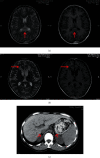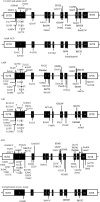Identification of Two Novel Mutations of ABCD1 Gene in Pedigrees with X-Linked Adrenoleukodystrophy and Review of the Literature
- PMID: 35479665
- PMCID: PMC9038410
- DOI: 10.1155/2022/5479781
Identification of Two Novel Mutations of ABCD1 Gene in Pedigrees with X-Linked Adrenoleukodystrophy and Review of the Literature
Abstract
Background: X-linked adrenoleukodystrophy (ALD) is an inherited peroxisomal metabolism disorder, resulting from the loss-of-function mutation of ATP-binding cassette protein subfamily D1 (ABCD1) gene. The dysfunction of ALD protein, a peroxisomal ATP-binding cassette transporter, results in the excessive saturated very long-chain fatty acids (VLCFAs) accumulation in organs including the brain, spine, and adrenal cortex. X-ALD is characterized as the childhood, adolescent, adult cerebral ALD, adrenomyeloneuropathy (AMN), adrenal insufficiency, and asymptomatic phenotypes, exhibiting a high variety of clinical neurological manifestations with or without adrenocortical insufficiency.
Results: In this study, we reported two cases of X-ALD, which were first diagnosed as adrenal insufficiency (Addison's disease) and treated with adrenocortical supplement. However, both of the cases progressed as neurological symptoms and signs after decades. Elevated VLCFAs level, brain MRI scan, and genetic analysis confirmed final diagnosis. In addition, we identified two novel mutations of ABCD1 gene, NM_000033.3 (ABCD1): c.874_876delGAG (p.Glu292del) and NM_000033.3 (ABCD1): c.96_97delCT (p.Tyr33Profs∗161), in exon 1 of ABCD1 gene. Sanger sequencing confirmed that the proband's mother of the first case was heterozygous carrying the same variant. Adrenal insufficiency-only type is very rare; however, it may be the starting performance of X-ALD. In addition, we summarized reported mutation sites and clinical manifestations to investigate the correlationship of phenotype-genotype of X-ALD.
Conclusions: The early warning manifestations should be noticed, and the probability of X-ALD should be considered. This report could be beneficial for the early diagnosis and genetic counseling for patients with X-ALD.
Copyright © 2022 Bingzi Dong et al.
Conflict of interest statement
The authors declare that they have no conflicts of interest.
Figures





References
LinkOut - more resources
Full Text Sources

